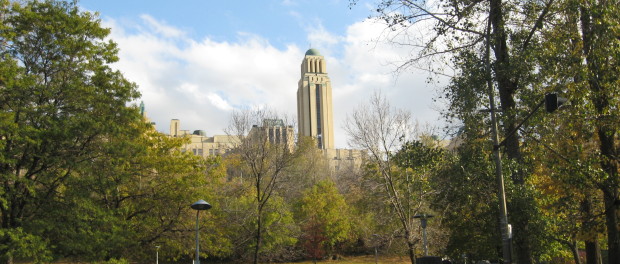The University on the Other Side of the Hill & Other Quebec Curios
The Université de Montréal is the same and yet different from the three universities we have already seen: where Laval is in Quebec City, it is in Montreal; where McGill is somewhat square and sprawling in its campus, the Université de Montréal campus spreads over almost an entire boulevard and is serviced by three metro stations; where Bishop’s is small, it has over forty thousand undergraduates alone. Its total student population is the highest of the four major Quebec universities of Montreal, roughly tied with Concordia, and it has two affiliated (yet independent) schools: HEC Montréal, a business school, and École Polytechnique, an engineering school.
The Université de Montréal (“UdeM” for those of us who know better) wasn’t created out of a desire for immortality. The university was created out of need of space, or, rather, a want of space: it was an offshoot of the Université Laval, Quebec’s oldest university. That’s right. The campus was originally called the Université de Laval à Montréal, founded in 1878. Apparently, this wasn’t good news to a high-ranking clergyman in Camp Montréal, since he wanted an independent university. And he would get it—in 1919, that is, through a charter by the Pope. He probably wasn’t around by then.
Even before UdeM was a thought in anyone’s mind, the Quebec Seminary already founded what would be the Faculty of Medicine as two separate schools (Medicine and Surgery) in 1843 and 1876. UdeM’s Faculty of Law would be founded in 1892. By the end of the nineteenth century, UdeM would have three faculties with less than one hundred students spread in each: Divinity, Law, and Medicine. Most classes were spread between the Quebec Seminary and the Chateau Ramezay in Old Montreal, and throughout the twentieth century, around St. Catherine and St. Denis. UdeM would have a key role in the Manhattan Project, researching nuclear reactors to create the atomic bomb during the Second World War (whose Los Alamos branch was famously under the direction of J. Robert Oppenheimer).
Prior to the modernisation of Quebec’s education systems, the UdeM was almost cursed with unluckiness: with the accumulation of the downtown campus’ three fires, a lack of funding, and crumbling buildings to start with (sound familiar?), the school was rather down on its luck. In the 1930s, the school secured funding and a chunk of territory to build its present campus on the other side of Mount Royal, with architectural plans built by Ernest Cormier, an engineer inspired by the Art Deco movement. Cormier, whose architecture lives on in the Supreme Court of Canada’s building, designed UdeM’s classic tower, the Roger Gaudry tower, named after the university’s first secular rector. Construction had to halt because of the financial difficulties of the Great Depression, but was officially finished in 1943. And yet through triumph and tragedy, UdeM seems to remain.
UdeM’s graduates include ten premiers of Quebec (including our law school premiers), Governor General Michaëlle Jean, Supreme Court Justice Louise Arbour, and former late Prime Minister of Canada, Pierre Elliott Trudeau.






